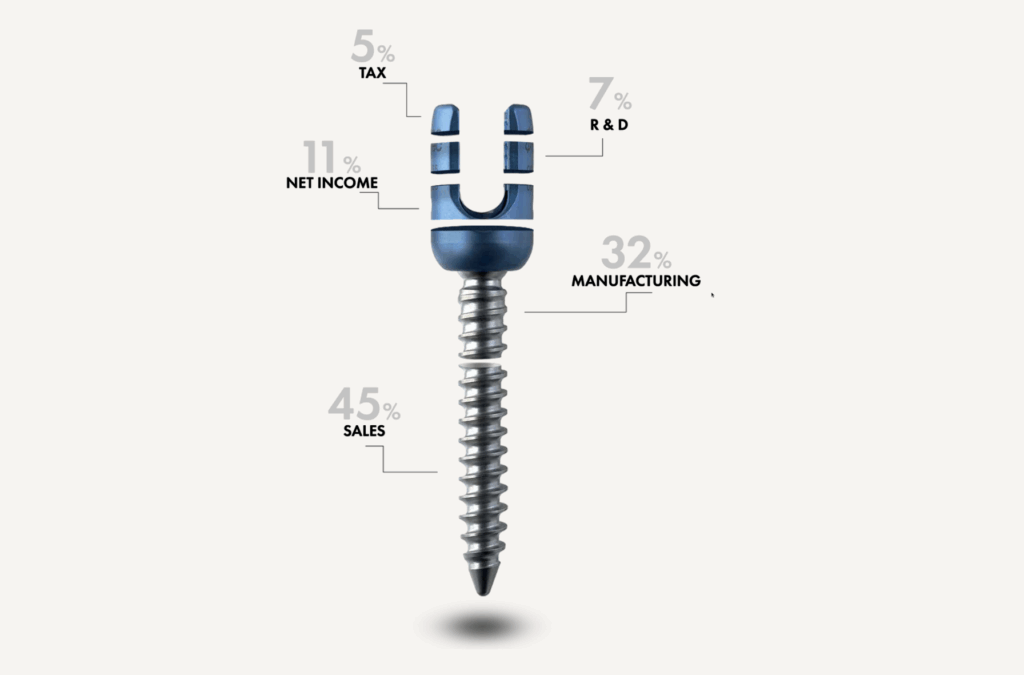Introduction: More Than Just Metal and Plastic
Hospitals across the U.S. routinely spend millions on surgical implants—from spine and orthopedic devices to cardiac and neurostimulation technologies. But here’s a critical question: What are they really paying for?
Spoiler alert: It’s not just the hardware.
Back in 2013, med-tech companies like LDR, NuVasive, and Globus reported allocating over 40–60% of their revenue to Selling, General & Administrative (SG&A) expenses. More than a decade later, little has changed. Today’s largest device manufacturers still spend 30–35% of revenue on SG&A, primarily to support sales reps, field coverage, and procedural assistance.
If your hospital is spending $10 million on implants, you’re not just paying for the device—you’re underwriting a massive commercial infrastructure.
In this post, we’ll unpack where implant dollars really go, why this system persists, and how healthcare leaders can gain visibility and control over these costs without compromising patient care.
SG&A: The Hidden Cost in Your Implant Spend
What is SG&A in the Medical Device World?
In business terms, SG&A (Selling, General & Administrative) includes:
Sales force salaries and commissions
Travel and lodging for field reps
Marketing and promotional materials
Managerial overhead
Office and administrative expenses
In the world of med-tech, case coverage—a representative being present in the OR to assist with device setup and use—is a significant part of this expense.
The Numbers: Then and Now
2013: Spine and ortho device makers spent 40–60% of revenue on SG&A
Today: Industry leaders still spend 30–35% on SG&A
For every $1,000 spent on an implant, $300+ goes toward non-clinical overhead
This means that hospitals paying $10M annually on implants are likely spending $3–$4 million on rep-driven support models—not on the devices themselves.
Why This Sales Model Persists
1. Clinical Complexity
Implants are complex. Surgeons often require specialized tools and techniques. Device reps are trained to support these procedures, ensuring correct instrumentation and technique during surgery.
2. Preference-Based Purchasing
Surgeons develop loyalties to certain vendors and tools, which can limit standardization across the facility. As a result, inventory variety explodes, and with it, the need for rep-based support increases.
3. Lack of Visibility
Most hospitals don’t have a granular understanding of what drives implant costs beyond invoice pricing. Without clear cost attribution, SG&A overhead remains hidden behind the sticker price.
The Real-World Impact on Hospitals
When hospitals cover the cost of sales reps and distribution infrastructure, they indirectly pay for:
Duplicate inventory across vendors
Sales commissions embedded in pricing
Inconsistent documentation and billing workflows
Unnecessary variation in surgical supplies
Vendor-driven scheduling inefficiencies
The result? Reduced margins, increased administrative burden, and missed opportunities for supply chain optimization.
Rethinking Implant Spend: What Hospitals Can Do
1. Gain Line-of-Sight Into SG&A Costs
Use analytics platforms that break down implant spend by:
Vendor
Procedure type
Surgeon preference
Inventory usage and waste
When administrators and supply chain leaders understand where costs originate, they’re empowered to make data-driven decisions.
2. Consolidate Vendors and Standardize
Reducing vendor variability can:
Lower prices through volume discounts
Eliminate redundant inventory
Reduce reliance on external rep support
Hospitals that standardize can move toward rep-less or rep-light models supported by internal clinical specialists.
3. Streamline Communication and Case Coordination
Rep-heavy models often create coordination bottlenecks due to fragmented scheduling and manual communication.
HUB Healthcare’s care coordination platform automates communication, integrates vendor tasks, and streamlines case scheduling—removing friction from implant logistics.
4. Align Surgeon Incentives With System Goals
Provide transparency to surgeons on cost differences across implants and vendors. When surgeons are part of the cost-saving conversation, they’re more likely to support standardization efforts that improve both outcomes and efficiency.
Emerging Trends: The Rise of Rep-Less Models
Some health systems are already transitioning to rep-less or hybrid models where:
Internal surgical techs or coordinators manage implant logistics
Vendor reps are no longer required in the OR
Standardized implant systems are used across providers
This evolution is made possible by:
Digitized surgical preference cards
Inventory tracking platforms
Automated case planning tools
Integrated communication platforms like HUB Healthcare
These tools provide the coordination and support reps traditionally offered—without the costly SG&A burden.
Case Study: How Cost Transparency Changed the Game
A large orthopedic surgery center using HUB Healthcare discovered that 20% of implant-related spend was tied to last-minute scheduling changes and redundant rep coordination.
After implementing a centralized communication and inventory management system:
Supply costs dropped by 12%
Cancellation rates declined by 25%
Surgeon satisfaction increased due to improved scheduling accuracy
This transformation wasn’t driven by new contracts—but by visibility, coordination, and workflow optimization.
Conclusion: It’s Time to Ask the Right Questions
When hospitals spend $10 million on implants, they should ask:
How much of this goes to actual device costs?
What portion funds rep coverage, sales commissions, and marketing?
Can we maintain surgical quality while reducing unnecessary overhead?
By improving communication, standardizing workflows, and leveraging advanced care coordination platforms, hospitals can reclaim control over implant costs—while maintaining clinical excellence.
How HUB Healthcare Can Help
HUB Healthcare offers a comprehensive solution designed to enhance communication in healthcare, streamline care coordination, and improve overall workflow efficiency. Our platform includes features such as medical case management software, healthcare document management, and healthcare analytics to ensure that all aspects of patient care are optimized. By leveraging HUB Healthcare’s robust tools, organizations can reduce workflow bottlenecks, automate repetitive tasks, and facilitate better collaboration among healthcare providers. This not only improves work quality but also enhances patient outcomes, making HUB Healthcare an essential partner in achieving healthcare excellence.






